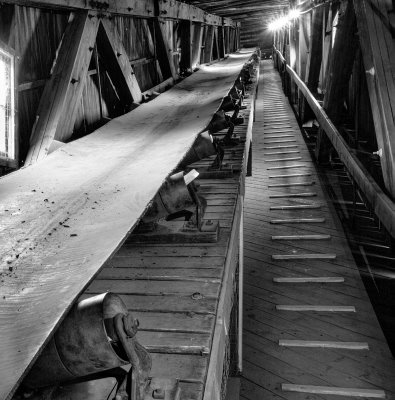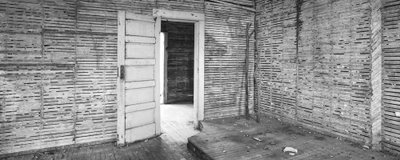Had a three day weekend off, you'd think I could have got out and photographed but other than the grass image of Friday, I haven't had a chance. Christmas shopping, plumbing problems, time with my wife, they all add up, and I have it easy, my only child is 24, grown up and away from home - but hey, she's coming home for Christmas.
Sometimes I use statcounter to check to see who's visiting my site and from where. Not uncommonly this leads to someone else's blog and yesterday I read about the impending deadline for Review Santa Fe, a juried (90 applications accepted out of several hundred) to have your portfolio reviewed by a series of professionals from the art, museum, gallery, publishing, and professional photographic world.
Even if you aren't about to present your work to be juried or hoping for publication, it can be a worthwile exercise to decide on a theme and collect a series of images which you could present as a portfolio.
I chose to use the ranking facilities of Adobe Bridge (though in the future that might be Lightroom or some other cataloguing programme. I had a large collection of images that I'd prepared for the web so used that as a catalogue.
I had to pick a group of related images that could be explained by a single theme. Rules specified it could be either colour or black and white but not both which is pretty standard. I elected to choose colour images rather than black and white. This is not a trivial decision as I think I have some strong images in both media. I elected to go with colour for several reasons. First is that I suspect there will be a lot more black and white than colour work being shown at what is largely a fine art venue - it doesn't hurt to differentiate myself from the herd. Second, I picked industrial as my theme for two reasons. First is that colour landscapes run the risk of being better suited to calendars and postcards than galleries, but also the industrial images are less commonly seen and a particular interest of mine. I also had to take into consideration whether I have enough good images of any given category to provide enough images to make a strong portfolio. The rules for Review Santa Fe specify 20 images or less but imply that less could be conceived as a photographer lacking depth and in some circumstances would be a disadvantage. Right so I have my goal - 20 colour industrial images, reasonably compatible with each other and all strong enough to withstand critical reviews (and even get past the jury in the first place).
I selected out the colour industrial images and then added a few more I set the star rating on all to zero. I then set up a slide show and went through the images a few times and on the third trip through, started assigning stars to the images. Images I knew I'd want for the portfolio got five stars, possibles got 3 stars. I could now show only the three and more star images and went through several more times, raising and lowering the star count for images.
I'm sure you have your own way of rating pictures and making selections, what I really wanted to talk about is the issue of 'good enough' and 'nice' and 'wow'.
I ended up with a collection of about 30 images, all colour, all more or less industrial in theme.
First I eliminated images which while popular locally, really only work if you happen to live in Calgary. Next I eliminated a couple of images that while having lovely colour , were lacking compositionally.
I eliminated an image of window reflections downtown since it wasn't really 'industrial'. I added several images which while never popular in terms of sales, are I think good work. This portfolio is about my work, my creativity, my art, not about my sales. I wouldn't include work that has been received poorly by more than one critic but an image can be creative, strongly composed, meaningful and still not be something even I would hang on my living room wall.
I had read that the reviewers would be asking why a lot - why did you take this picture?, why did you compose it this way?, why does it mean something to you?, why did you think I needed to see it?
I imagined myself having to justify each of the images, and a few more that were just 'pretty' hit the dust.
Even if you aren't planning a submission, you might want to 'justify' a collection of your images like this. Imagine a stern looking reviewer peering over their bifocals an down their nose (can you do both?) and asking in a less than friendly tone one of the following questions.
1) why did you take this picture?
2) what makes you think someone else, anyone else, I, should look at this photograph?
3) what was important about the subject matter to you?
4) how does this image relate to the others you have shown me?
5) what are you trying to say with this image?
If you have ever presented your work at a workshop or to a gallery you are familiar with the types of questions that are asked. Note that they never ask about f stops, focal lengths or the number of pixels. That would be too easy. No they ask the tough ones, the ones that put you on the spot, the ones that can leave your jaw hanging, glassy eyed and tongue tied.
You could reject these questions as irrelevent but the answers are I think important, educating and self revealing. I think having answers will help you be a better photographer, more discriminative but also more focused on images that work.
If the only thing you can say about an image is it's nice, how the hell are you going to find more 'nice' images other than through luck? If on the other hand you can say it's nice because I like the solitude, or the power of water to erode this canyon, or the effect of time on this rusting machinery, or the feeling of power from this old locomotive; then you are in a much stronger position to make another strong image.
You may tell yourself that you take pictures because the alternative was cleaning the furnace room, that your doctor told you you needed a hobby, that you do it because you like 'playing' with beautiful tools.
ALl those points are right (not that you'd want to tell the reviewer that), but if you think about it, some things make you raise your camera and others don't. Some images make you think the trouble and expense were worth it, others do not. There are more profound reasons to shoot and to select certain images. You just need to do a little digging to find out what it might be, and you will be on your way to taking other good images.





















































